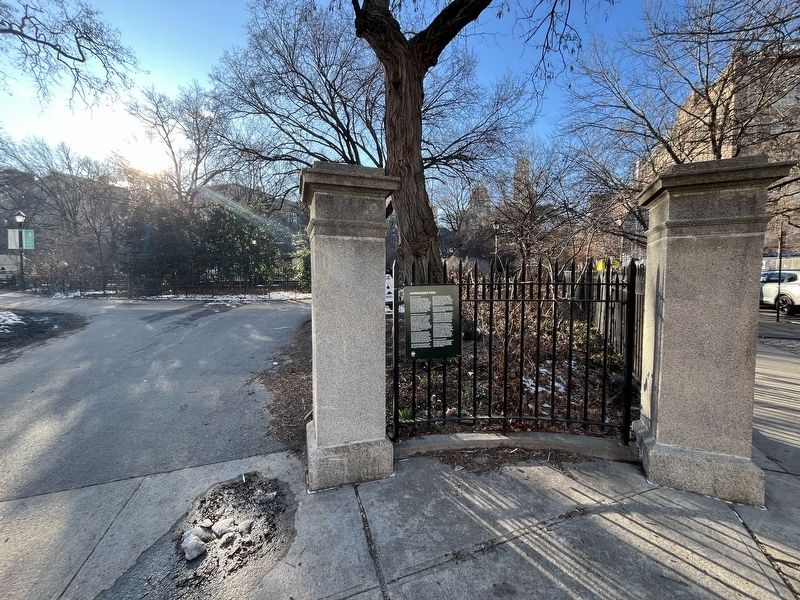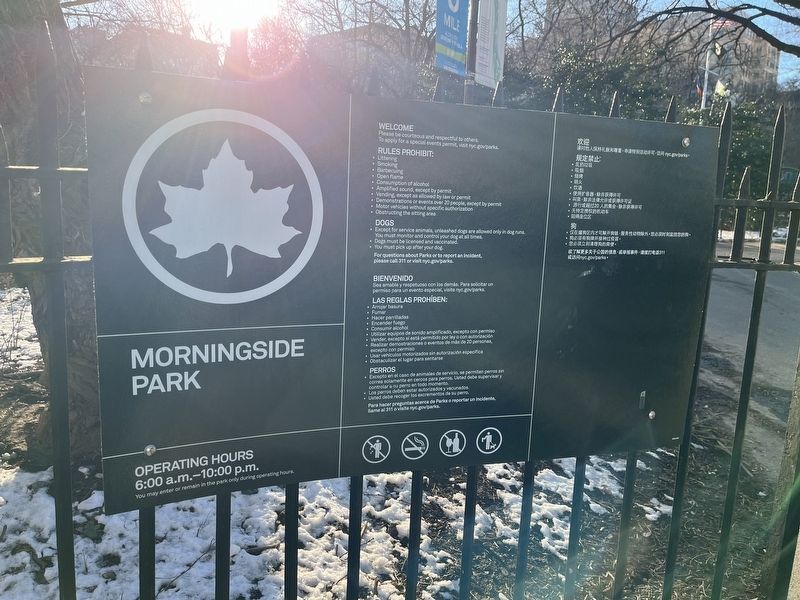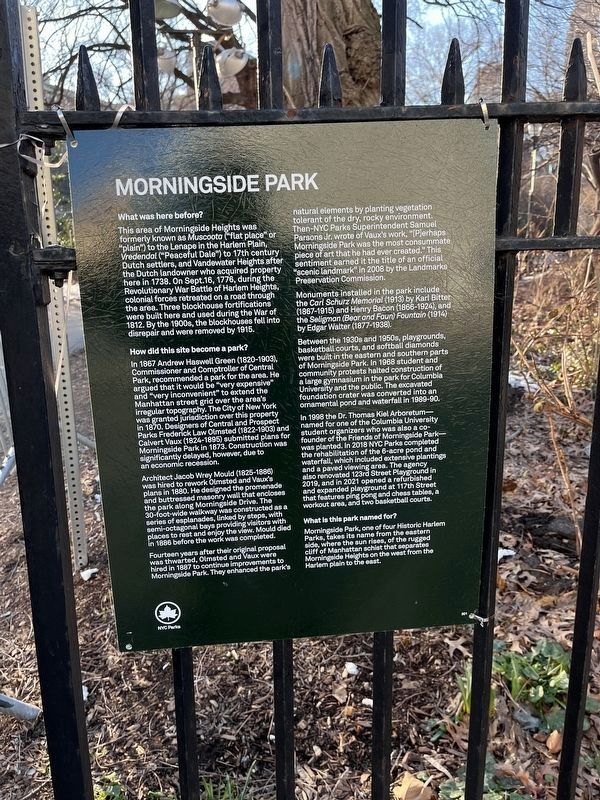Morningside Park in Manhattan in New York County, New York — The American Northeast (Mid-Atlantic)
Morningside Park
What was here before?
This area of Morningside Heights was formerly known as Muscoota ("flat place" or "plain") to the Lenape in the Harlem Plain, Vrendendal ("Peaceful Dale") to 17th century Dutch settlers, and Vandewater Heights after the Dutch landowner who acquired property here in 1738. On Sept. 16, 1776, during the Revolutionary War Battle of Harlem Heights, colonial forces retreated on a road through the area. Three blockhouse fortifications were built here and used during the War of 1812. By the 1900s, the blockhouses fell into disrepair and were removed by 1915.
How did this site become a park?
In 1867 Andrew Haswell Green (1820-1903), Commissioner and Comptroller of Central Park, recommended a park for the area. He argued that it would be "very expensive" and "very inconvenient" to extend the Manhattan street grid over the area's irregular topography. The City of New York was granted jurisdiction over this property in 1870. Designers of Central and Prospect Parks Frederick Law Olmsted (1822-1903) and Carl Vaux (1824-1895) submitted plans for Morningside Parks in 1873. Construction was significantly delayed, however, due to an economic recession.
Architect Jacob Wrey Mould (1825-1886) was hired to rework Olmsted and Vaux's plans in 1880. He designed the promenade and buttressed masonry wall that encloses the park along Morningside Drive. The 30-foot-wide walkway was constructed as a series of esplanades, linked by steps, with semi-octagonal bays providing visitors with places to rest and enjoy the view. Mould died in 1886 before the work was completed.
Fourteen years after their original proposal was thwarted, Olmsted and Vaux were hired in 1887 to continue improvements to Morningside Park. They enhanced the park's natural elements by planting vegetation tolerant of the dry, rocky environment. Then-NYC Parks Superintendent Samuel Parsons Jr. wrote of Vaux's work, "[P]erhaps Morningside Park was the most consummate piece of art that he had ever created." This sentiment earned it the title of "scenic landmark" in 2008 by the Landmarks Preservation Commission.
Monuments installed in the park include the Carl Schurz Memorial (1913) by Karl Bitter (1867-1915) and Henry Bacon (1866-1924), and the Seligman (Bear and Faun) Fountain (1914) by Edgar Walter (1877-1938).
between the 1930s and 1950s, playgrounds, basketball courts, and softball diamonds were built in the eastern and southern parts of Morningside Park. In 1968 student and community protests halted construction of a large gymnasium in the park for Columbia University and the public. The excavated foundation crater was converted into an ornamental

Photographed By Devry Becker Jones (CC0), February 16, 2024
2. Morningside Park Marker at the entrance to the park
In 1998 the Dr. Thomas Karl Arboretum—named for one of the Columbia University student organizers who was also a co-founder of the Friends of Morningside Park—was planted. In 2018 NYC Parks completed the rehabilitation of the 6-acre pond and waterfall, which included extensive plantings and a paved viewing area. The agency also renovated 123rd Street Playground in 1929, and in 2021 opened a refurbished and expanded playground at 117th Street that features ping pong and chess tables, a workout area, and two basketball courts.
What is this park named for?
Morningside Park, one of four Historic Harlem Parks, takes its name from the eastern side, where the sun rises, of the rugged cliff of Manhattan schist that separates Morningside Heights on the west from the Harlem plain to the east.
Erected by NYC Parks. (Marker Number 301.)
Topics and series. This historical marker is listed in these topic lists: Architecture • Native Americans • Parks & Recreational Areas • War, US Revolutionary. In addition, it is included in the NYC Parks series list. A significant historical date for this entry is September 16, 1776.
Location. 40° 48.601′ N, 73° 57.315′ W. Marker is in Manhattan, New York, in New York County. It is in Morningside

Photographed By Devry Becker Jones (CC0), February 16, 2024
3. NYC Parks signage for Morningside Park
Other nearby markers. At least 8 other markers are within walking distance of this marker. Roosevelt Triangle (about 600 feet away, measured in a direct line); Swing Low: Harriet Tubman Memorial (approx. 0.2 miles away); Oscar J. Hijuelos (approx. ¼ mile away); New York City Defenses During the War of 1812 (approx. 0.3 miles away); Carl Schurz Monument (approx. 0.4 miles away); Low Memorial Library (approx. 0.4 miles away); Adam Clayton Powell, Jr. (approx. 0.4 miles away); GreenThumb (approx. 0.4 miles away). Touch for a list and map of all markers in Manhattan.
Related marker. Click here for another marker that is related to this marker. An identical marker can be found elsewhere in the park.
Additional keywords. landscape architecture
Credits. This page was last revised on March 11, 2024. It was originally submitted on February 21, 2024, by Devry Becker Jones of Washington, District of Columbia. This page has been viewed 50 times since then. Photos: 1, 2, 3. submitted on February 21, 2024, by Devry Becker Jones of Washington, District of Columbia.
